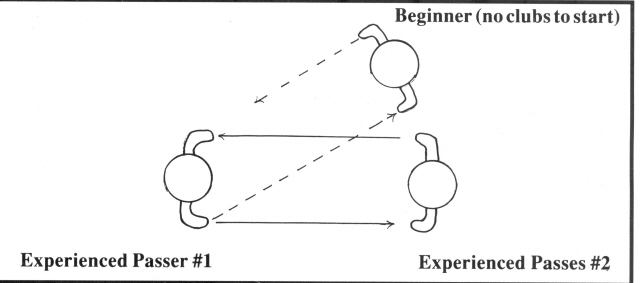 |
Page 36 Spring 1989
|
Kick
Your Shoulder Pass Unlike
a pass, the shoulder throw should actually be short so that it drops
in front of your right foot. Make it into a pass by kicking it to
your partner. Shoulder
Surprise After
a pass in ever others, do a left hand de-multiplex, or buy right
hand time any way you prefer. Then do a club swing with your right
hand -- two small forward circles from your wrist with your hand low
at the side of your body, using a ball and socket grip. To a person
standing at your right it would appear as a clockwise movement
centered in front of your hip pocket. Instead of a pass, let go of
the club at the end of the second circle so that it sails up from
behind your body and ends up after three spins being caught by your
left hand.
This
skill is founded on triple spin self throw instead of a pass. Do you
understand this one? No? Well, no problem. Use it as food for
thought to create your own similar combination! Terminology
(Jeff Napier is a juggler and businessman living in Phoenix, Oregon. He is author of the book "Six Club Passing." ) A Passing Game by
Michael Stillwell The
following is a fun game for experienced club passers, but I present
it here as a method for teaching a beginner to pass.
First,
face the beginner and using one club, teach him or her the basic
passing pattern.
The beginner must understand that all clubs are caught with the left
hand, thrown to the right, then passed to the partner's left.
Now
stand as shown in the illustration and begin the passing lesson. The
two experienced jugglers pass six clubs, throwing every throw. After a
time, number one throws a single club across the pattern to the
beginner, who does a self |
 |